What is Check-the-weather.com?
Check-the-weather.com pop-ups are a scam that uses the browser notification feature to fool users into allowing push notifications from malicious (ad) push servers. Scammers use push notifications to bypass protection against pop ups in the web-browser and show lots of unwanted ads. These ads are used to promote suspicious browser extensions, prize & lottery scams, fake software, and adult web-pages.
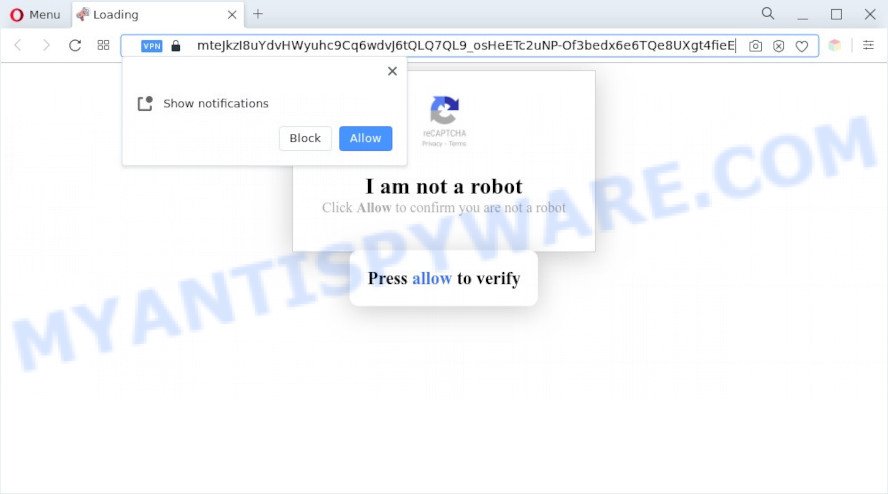
Check-the-weather.com is a misleading site that states that you need to click ‘Allow’ in order to access the content of the web-site, enable Flash Player, watch a video, connect to the Internet, download a file, and so on. If you click on the ‘Allow’ button, then your web-browser will be configured to show intrusive adverts on your desktop, even when the internet browser is closed.

Threat Summary
| Name | Check-the-weather.com popup |
| Type | browser notification spam, spam push notifications, pop-up virus |
| Distribution | adware software, dubious popup advertisements, social engineering attack, PUPs |
| Symptoms |
|
| Removal | Check-the-weather.com removal guide |
How does your personal computer get infected with Check-the-weather.com pop-ups
These Check-the-weather.com pop-ups are caused by dubious ads on the webpages you visit or adware software. Adware is a form of malware. It have various methods of earning by showing the ads forcibly to its victims. Adware can open popup deals, show unsolicited advertisements, alter the victim’s web-browser settings, or redirect the victim’s internet browser to scam web-pages. Aside from causing unwanted ads and web-browser redirects, it also can slow down the computer.
Usually, adware software gets into computers as part of a bundle with freeware, sharing files and other unsafe apps which you downloaded from the Internet. The authors of adware software pays software authors for distributing adware within their apps. So, third-party software is often included as part of the installer. In order to avoid the installation of any adware: choose only Manual, Custom or Advanced install type and reject all optional software in which you are unsure.
Remove Check-the-weather.com notifications from web-browsers
If the scammers have achieved their goal and you clicked the Allow button, then you need to open web browser settings as soon as possible and disable rogue notifications. To remove the Check-the-weather.com notifications, follow the steps below. These steps are for MS Windows, Mac OS and Android.
Google Chrome:
- In the top right hand corner of the browser window, expand the Chrome menu.
- When the drop-down menu appears, click on ‘Settings’. Scroll to the bottom of the page and click on ‘Advanced’.
- When the drop-down menu appears, tap ‘Settings’. Scroll down to ‘Advanced’.
- Go to Notifications settings.
- Find the Check-the-weather.com site and delete it by clicking the three vertical dots on the right to the site and select ‘Remove’.
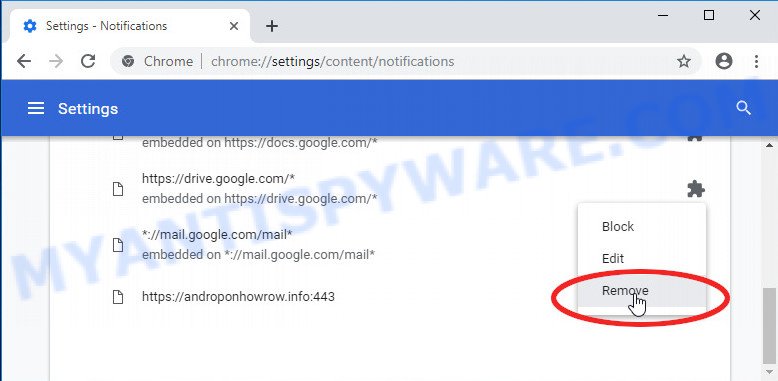
Android:
- Tap ‘Settings’.
- Tap ‘Notifications’.
- Find and tap the web-browser that shows Check-the-weather.com notifications ads.
- Locate Check-the-weather.com in the list and disable it.
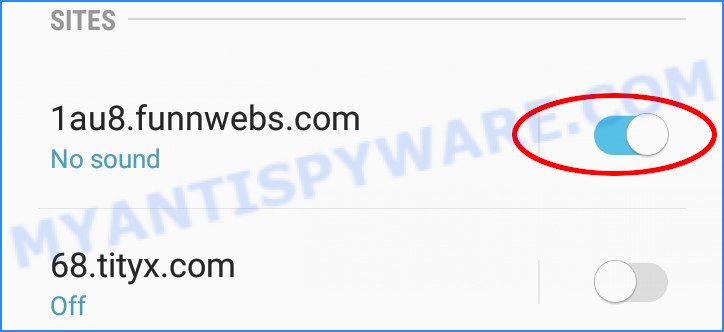
Mozilla Firefox:
- In the top right hand corner of the Firefox, click the Menu button, represented by three horizontal stripes.
- In the menu go to ‘Options’, in the menu on the left go to ‘Privacy & Security’.
- Scroll down to the ‘Permissions’ section and click the ‘Settings’ button next to ‘Notifications’.
- Locate sites you down’t want to see notifications from (for example, Check-the-weather.com), click on drop-down menu next to each and select ‘Block’.
- Save changes.
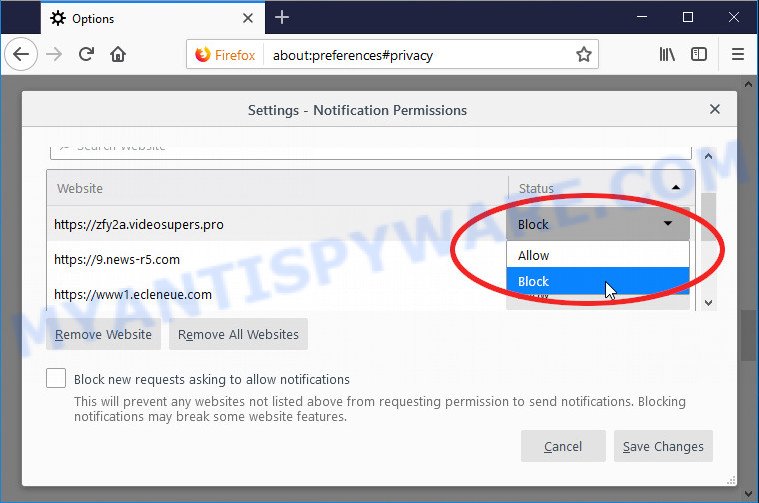
Edge:
- In the top right corner, click on the three dots to expand the Edge menu.
- Scroll down, find and click ‘Settings’. In the left side select ‘Advanced’.
- Click ‘Manage permissions’ button below ‘Website permissions’.
- Right-click the Check-the-weather.com URL. Click ‘Delete’.
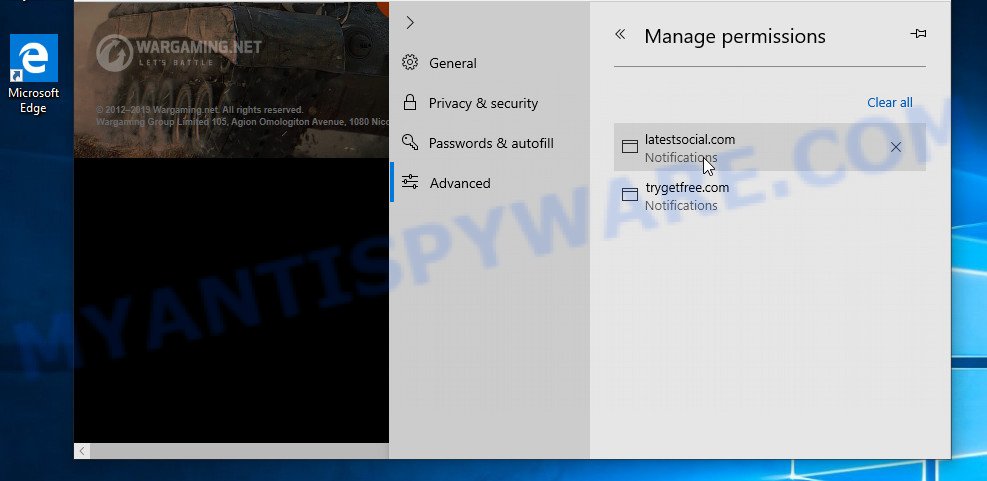
Internet Explorer:
- Click ‘Tools’ button in the right upper corner of the browser.
- In the drop-down menu select ‘Internet Options’.
- Click on the ‘Privacy’ tab and select ‘Settings’ in the pop-up blockers section.
- Select the Check-the-weather.com domain and other suspicious sites under and delete them one by one by clicking the ‘Remove’ button.
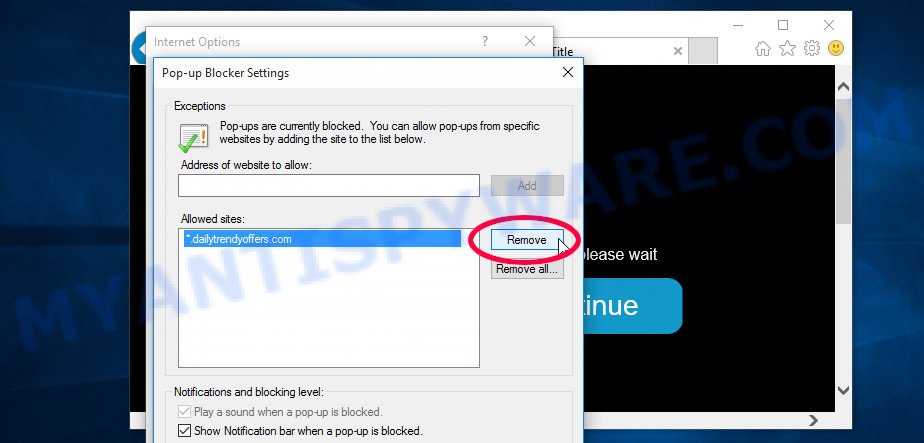
Safari:
- Go to ‘Preferences’ in the Safari menu.
- Select the ‘Websites’ tab and then select ‘Notifications’ section on the left panel.
- Check for Check-the-weather.com domain, other questionable URLs and apply the ‘Deny’ option for each.
How to remove Check-the-weather.com popup advertisements (removal guidance)
We are presenting a few ways to remove Check-the-weather.com pop-up advertisements from the Firefox, Google Chrome, Microsoft Internet Explorer and Microsoft Edge using only internal Windows functions. Most of adware and potentially unwanted applications can be uninstalled via these processes. If these steps does not help to delete Check-the-weather.com ads, then it’s better to run a free malware removal tools linked below.
To remove Check-the-weather.com pop ups, complete the following steps:
- Remove Check-the-weather.com notifications from web-browsers
- How to remove Check-the-weather.com popups without any software
- Automatic Removal of Check-the-weather.com advertisements
- Stop Check-the-weather.com pop-ups
How to remove Check-the-weather.com popups without any software
In most cases, it is possible to manually get rid of Check-the-weather.com pop-ups. This method does not involve the use of any tricks or removal utilities. You just need to restore the normal settings of the personal computer and web browser. This can be done by following a few simple steps below. If you want to quickly remove Check-the-weather.com ads, as well as perform a full scan of your PC, we recommend that you run adware software removal utilities, which are listed below.
Delete PUPs through the MS Windows Control Panel
First, you should try to identify and uninstall the application that causes the appearance of intrusive advertisements or web-browser redirect, using the ‘Uninstall a program’ which is located in the ‘Control panel’.
Press Windows button ![]() , then press Search
, then press Search ![]() . Type “Control panel”and press Enter. If you using Windows XP or Windows 7, then press “Start” and select “Control Panel”. It will display the Windows Control Panel as on the image below.
. Type “Control panel”and press Enter. If you using Windows XP or Windows 7, then press “Start” and select “Control Panel”. It will display the Windows Control Panel as on the image below.
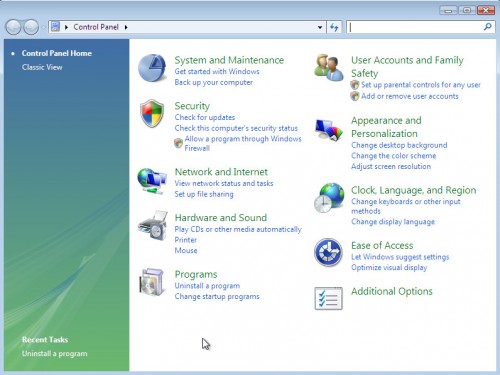
Further, click “Uninstall a program” ![]()
It will open a list of all apps installed on your computer. Scroll through the all list, and delete any dubious and unknown apps.
Remove Check-the-weather.com ads from Chrome
Reset Google Chrome settings is a simple way to delete Check-the-weather.com pop-ups, harmful and adware extensions, internet browser’s home page, search provider by default and newtab page that have been modified by adware.

- First, run the Chrome and click the Menu icon (icon in the form of three dots).
- It will show the Chrome main menu. Select More Tools, then press Extensions.
- You will see the list of installed extensions. If the list has the extension labeled with “Installed by enterprise policy” or “Installed by your administrator”, then complete the following instructions: Remove Chrome extensions installed by enterprise policy.
- Now open the Google Chrome menu once again, click the “Settings” menu.
- Next, click “Advanced” link, that located at the bottom of the Settings page.
- On the bottom of the “Advanced settings” page, click the “Reset settings to their original defaults” button.
- The Google Chrome will display the reset settings prompt as shown on the screen above.
- Confirm the web-browser’s reset by clicking on the “Reset” button.
- To learn more, read the blog post How to reset Google Chrome settings to default.
Remove Check-the-weather.com advertisements from Internet Explorer
The Internet Explorer reset is great if your internet browser is hijacked or you have unwanted add-ons or toolbars on your web-browser, that installed by an malicious software.
First, launch the Internet Explorer, then click ‘gear’ icon ![]() . It will open the Tools drop-down menu on the right part of the browser, then click the “Internet Options” like below.
. It will open the Tools drop-down menu on the right part of the browser, then click the “Internet Options” like below.

In the “Internet Options” screen, select the “Advanced” tab, then press the “Reset” button. The IE will open the “Reset Internet Explorer settings” dialog box. Further, click the “Delete personal settings” check box to select it. Next, click the “Reset” button like the one below.

After the process is complete, press “Close” button. Close the Internet Explorer and restart your personal computer for the changes to take effect. This step will help you to restore your web-browser’s home page, search engine and newtab to default state.
Delete Check-the-weather.com pop-ups from Mozilla Firefox
If the Firefox browser is redirected to Check-the-weather.com and you want to recover the Firefox settings back to their default state, then you should follow the few simple steps below. When using the reset feature, your personal information such as passwords, bookmarks, browsing history and web form auto-fill data will be saved.
Click the Menu button (looks like three horizontal lines), and press the blue Help icon located at the bottom of the drop down menu as shown in the figure below.
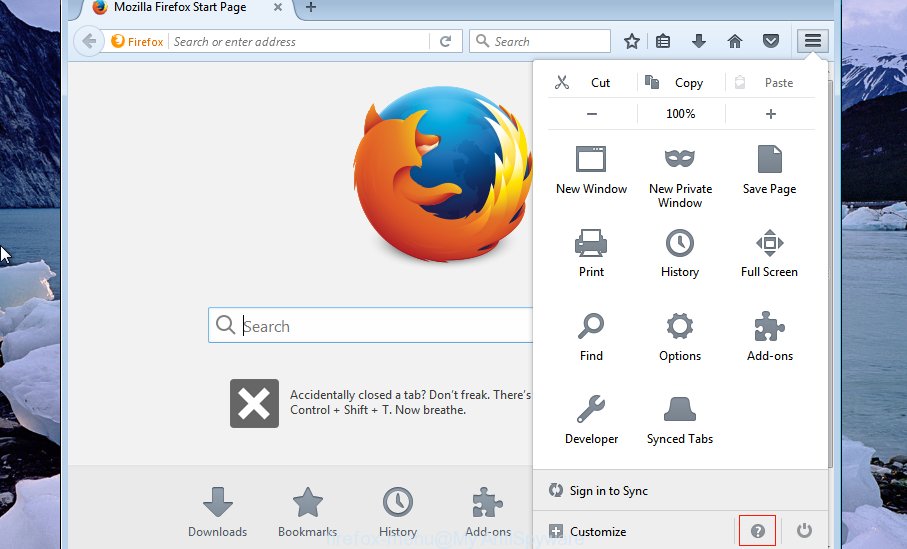
A small menu will appear, press the “Troubleshooting Information”. On this page, click “Refresh Firefox” button like below.

Follow the onscreen procedure to revert back your Firefox browser settings to their default values.
Automatic Removal of Check-the-weather.com advertisements
Manual removal tutorial does not always help to completely delete the adware, as it’s not easy to identify and delete components of adware and all malicious files from hard disk. Therefore, it’s recommended that you use malware removal utility to completely get rid of Check-the-weather.com off your browser. Several free malware removal utilities are currently available that can be used against the adware. The optimum solution would be to run Zemana Anti-Malware, MalwareBytes AntiMalware and HitmanPro.
Get rid of Check-the-weather.com ads with Zemana Anti-Malware
Zemana is a program that is used for malware, adware, browser hijackers and potentially unwanted applications removal. The application is one of the most efficient antimalware tools. It helps in malware removal and and defends all other types of security threats. One of the biggest advantages of using Zemana is that is easy to use and is free. Also, it constantly keeps updating its virus/malware signatures DB. Let’s see how to install and scan your PC system with Zemana in order to get rid of Check-the-weather.com pop ups from your PC.
Download Zemana by clicking on the link below.
165044 downloads
Author: Zemana Ltd
Category: Security tools
Update: July 16, 2019
Once the download is complete, close all windows on your device. Further, launch the setup file called Zemana.AntiMalware.Setup. If the “User Account Control” prompt pops up as on the image below, click the “Yes” button.
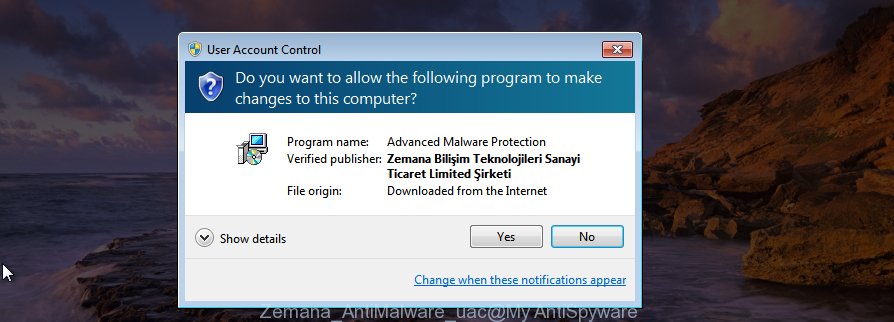
It will open the “Setup wizard” which will allow you install Zemana AntiMalware on the PC system. Follow the prompts and do not make any changes to default settings.
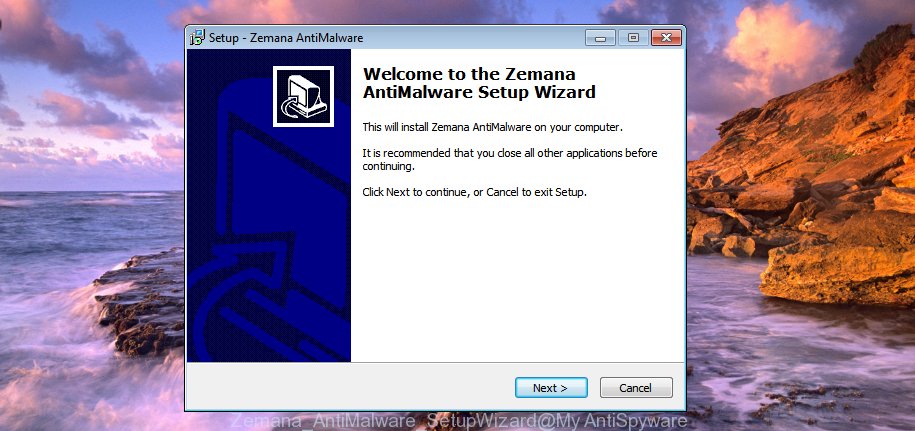
Once installation is finished successfully, Zemana will automatically start and you can see its main window as shown in the figure below.
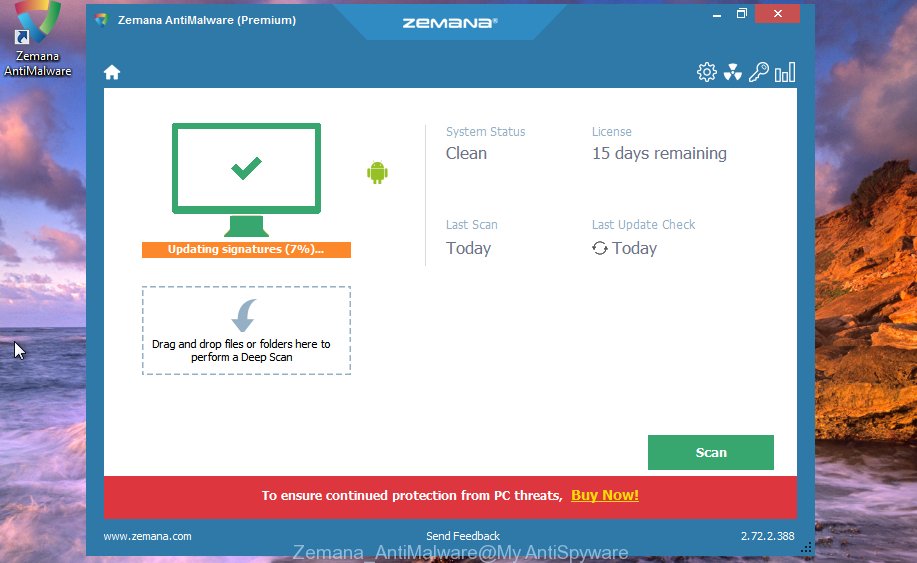
Next, click the “Scan” button . Zemana program will scan through the whole PC for the adware that causes Check-the-weather.com ads in your internet browser. A system scan can take anywhere from 5 to 30 minutes, depending on your PC. While the Zemana AntiMalware application is scanning, you can see count of objects it has identified as threat.

Once the scan get completed, a list of all threats detected is created. Review the report and then click “Next” button.
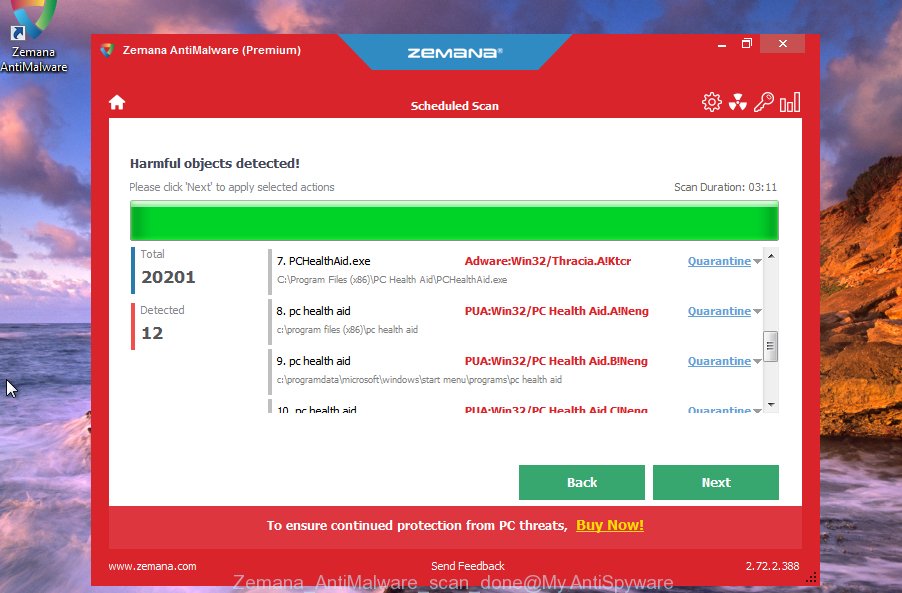
The Zemana Anti-Malware will remove adware that causes the unwanted Check-the-weather.com ads and move the selected threats to the Quarantine. After the process is done, you can be prompted to restart your PC system.
Delete Check-the-weather.com pop-up advertisements and harmful extensions with HitmanPro
Hitman Pro is a free application that developed to remove malicious software, PUPs, browser hijackers and adware software from your personal computer running Microsoft Windows 10, 8, 7, XP (32-bit and 64-bit). It’ll help to search for and remove adware software that causes the annoying Check-the-weather.com ads, including its files, folders and registry keys.
Visit the page linked below to download the latest version of HitmanPro for Microsoft Windows. Save it on your Desktop.
When the downloading process is complete, open the file location and double-click the HitmanPro icon. It will start the Hitman Pro utility. If the User Account Control prompt will ask you want to launch the program, press Yes button to continue.

Next, click “Next” . Hitman Pro program will scan through the whole PC system for the adware related to the Check-the-weather.com pop-up advertisements. Depending on your device, the scan can take anywhere from a few minutes to close to an hour. During the scan Hitman Pro will look for threats present on your device.
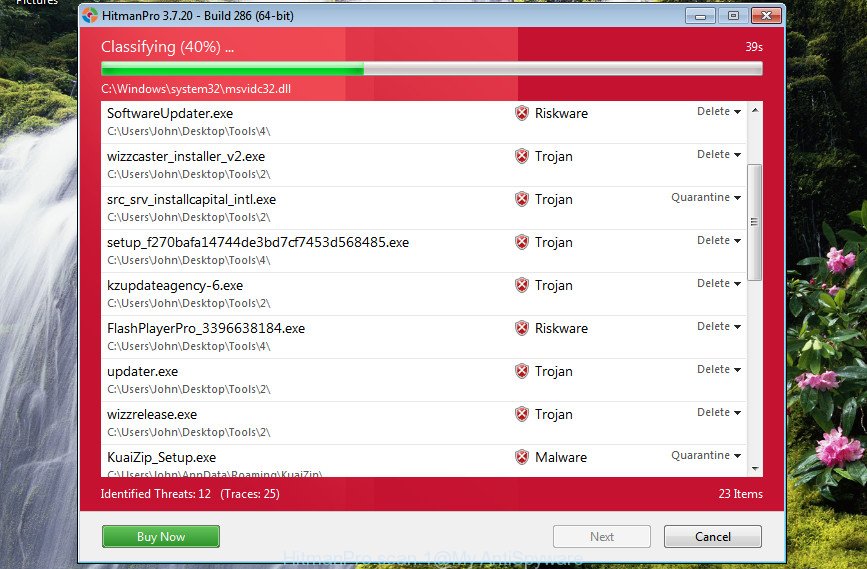
Once Hitman Pro has completed scanning, the results are displayed in the scan report as on the image below.
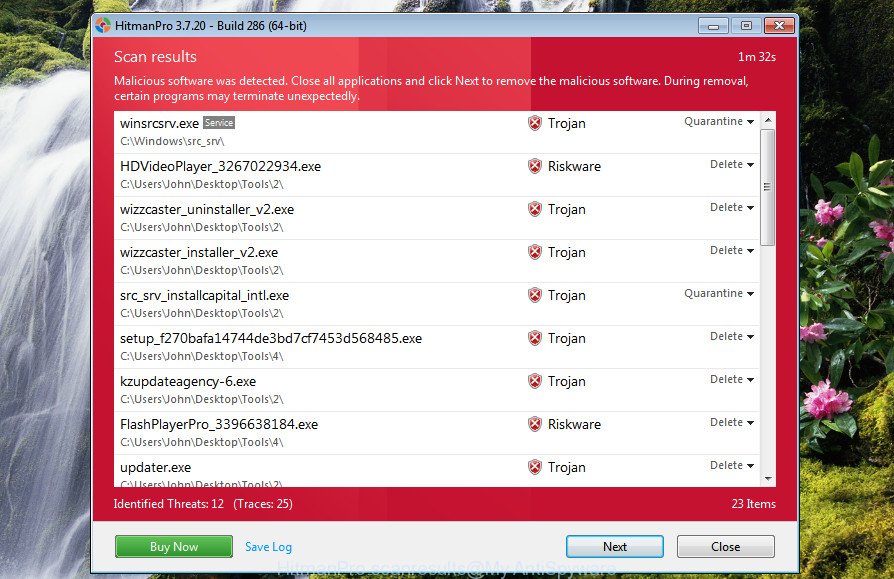
Review the results once the utility has finished the system scan. If you think an entry should not be quarantined, then uncheck it. Otherwise, simply click “Next” button. It will display a dialog box, click the “Activate free license” button. The Hitman Pro will delete adware that causes Check-the-weather.com advertisements in your web browser. Once that process is complete, the utility may ask you to reboot your computer.
Remove Check-the-weather.com popups with MalwareBytes Anti-Malware
If you are having problems with Check-the-weather.com ads removal, then check out MalwareBytes Anti-Malware. This is a utility that can help clean up your device and improve your speeds for free. Find out more below.
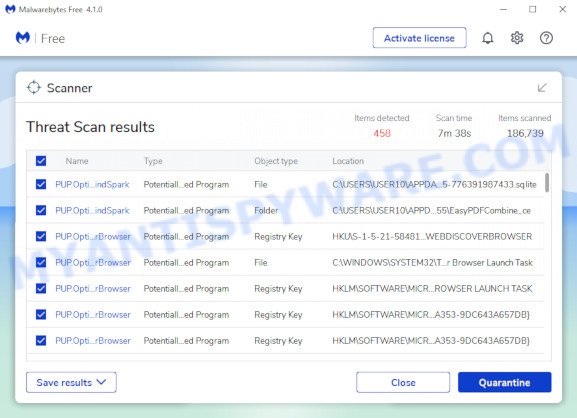
- Visit the following page to download MalwareBytes Anti-Malware. Save it to your Desktop so that you can access the file easily.
Malwarebytes Anti-malware
327273 downloads
Author: Malwarebytes
Category: Security tools
Update: April 15, 2020
- When the downloading process is finished, close all programs and windows on your personal computer. Open a folder in which you saved it. Double-click on the icon that’s named MBsetup.
- Choose “Personal computer” option and click Install button. Follow the prompts.
- Once setup is finished, click the “Scan” button to detect adware that causes multiple annoying popups. This procedure can take quite a while, so please be patient. While the MalwareBytes Anti-Malware program is checking, you can see how many objects it has identified as threat.
- Once MalwareBytes Anti-Malware completes the scan, MalwareBytes Anti-Malware will open a list of all threats detected by the scan. Once you’ve selected what you want to remove from your PC click “Quarantine”. After disinfection is done, you can be prompted to restart your computer.
The following video offers a step-by-step tutorial on how to remove browser hijackers, adware and other malicious software with MalwareBytes Anti-Malware.
Stop Check-the-weather.com pop-ups
Run an ad-blocker tool such as AdGuard will protect you from harmful ads and content. Moreover, you can find that the AdGuard have an option to protect your privacy and block phishing and spam web-sites. Additionally, ad-blocking applications will allow you to avoid intrusive pop-ups and unverified links that also a good way to stay safe online.
AdGuard can be downloaded from the following link. Save it to your Desktop.
26902 downloads
Version: 6.4
Author: © Adguard
Category: Security tools
Update: November 15, 2018
After downloading it, launch the downloaded file. You will see the “Setup Wizard” screen as on the image below.
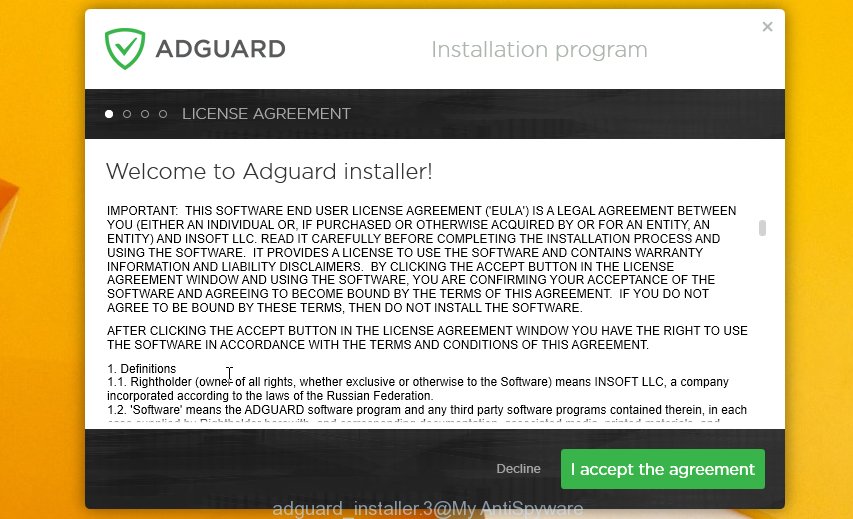
Follow the prompts. When the installation is finished, you will see a window as displayed in the following example.

You can press “Skip” to close the installation application and use the default settings, or click “Get Started” button to see an quick tutorial that will allow you get to know AdGuard better.
In most cases, the default settings are enough and you do not need to change anything. Each time, when you launch your personal computer, AdGuard will launch automatically and stop undesired advertisements, block Check-the-weather.com, as well as other harmful or misleading webpages. For an overview of all the features of the program, or to change its settings you can simply double-click on the AdGuard icon, which can be found on your desktop.
To sum up
Once you have removed the adware software using the steps, Chrome, Internet Explorer, Firefox and Edge will no longer display intrusive Check-the-weather.com web page when you browse the Internet. Unfortunately, if the few simple steps does not help you, then you have caught a new adware, and then the best way – ask for help.
Please create a new question by using the “Ask Question” button in the Questions and Answers. Try to give us some details about your problems, so we can try to help you more accurately. Wait for one of our trained “Security Team” or Site Administrator to provide you with knowledgeable assistance tailored to your problem with the annoying Check-the-weather.com pop-up advertisements.




















